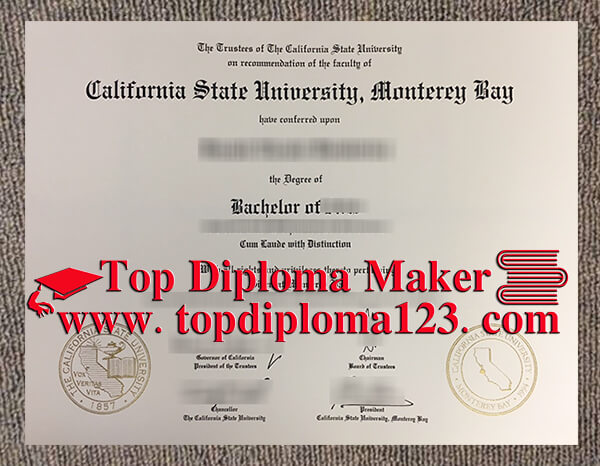 |
|
| Type | Public |
|---|---|
| Established | 1994 |
| Endowment | $27.1 million (2019)[1] |
| President | Eduardo M. Ochoa |
|
Academic staff
|
482 (Fall 2020)[2] |
| Students | 6,871 (Fall 2020)[3] |
| Undergraduates | 6,276 (Fall 2020)[3] |
| Postgraduates | 595 (Fall 2020)[3] |
| Location |
,
,
United States
36°39′12″N 121°47′47″WCoordinates: 36°39′12″N 121°47′47″W |
| Campus | 1,350 acres (5% of the former Fort Ord)[4] |
| Colors |
Bay blue, valley green and golden sand[5] |
| Athletics | NCAA Division II – CCAA |
| Nickname | Otters |
| Affiliations |
California State University system AASCU |
| Mascot | Monte Rey Otter |
| Website |
www |
 |
|
California State University, Monterey Bay (CSUMB or Cal State Monterey Bay) is a public university in Monterey County, California. Its main campus is located on the site of the former military base Fort Ord, straddling the cities of Seaside and Marina, about one mile inland from Monterey Bay along the Central Coast of California. CSUMB also has locations in the cities of Monterey and Salinas. Founded in 1994, CSUMB is part of the California State University system and is accredited by the WASC Senior College and University Commission.
History[edit]
CSUMB was founded in 1994 with a student enrollment of 654 students. Classes began August 28, 1995. The founding president was Peter Plympton Smith. It was the 22nd campus in the California State University system. The university offers 23 bachelor's degrees, 7 master's degrees, and teaching credentials.[6]
As of the fall 2020 semester, the university had 6,276 undergraduate students, 595 graduate students and 186 full-time faculty members.[3][2] The university operates on the semester system. The president is Eduardo M. Ochoa, who was appointed in May 2012.[7]
CSUMB, in conjunction with Hartnell College, developed CS-in-3, a three-year computer science program funded in part by grants from the Foundation established by Matsui Nursery.[8] A donation of 210 acres of prime agricultural land to the Hartnell College Foundation, valued at $20 million USD was granted thereafter.[9]
Presidents[edit]
| Name | Commenced term | Ended term | |
|---|---|---|---|
| 1. | Peter Plympton Smith | 1994 | 2005 |
| 2. | Diane Cordero de Noriega (Interim) | 2005 | 2006 |
| 3. | Dianne F. Harrison | 2006 | 2012 |
| 4. | Eduardo M. Ochoa | 2012 | N/A |
Demographics[edit]
| *Demographics of student body | Fall 2019[10] | Fall 2018[11] |
|---|---|---|
| Black/African American | 3% | 3.7% |
| Asian American | 5% | 2.9% |
| Filipino American | Null | 2.1% |
| Pacific Islander | 0% | 0.4% |
| White European Americans | 25% | 24.8% |
| Native American/American Indian | 0% | 0.2% |
| Hispanic/Latino Americans | 49% | Null |
| Mexican American/Chicano | Null | 41.1% |
| Other Latino America | Null | 6.0% |
| Multiracial Americans | 5% | 5.4% |
| Non-resident alien | 6% | 5.9% |
| Unknown | 6% | 7.5% |
Faculty[edit]
In the fall of 2020, of 482 teaching faculty, 262 held doctorates or another terminal degree, and 96 were members of minority groups.[2] The faculty includes an American Book Award winner and six Fulbright scholars.
Students[edit]
As of spring 2020, the student body was 62% female and 38% male. 33% of students enrolled were under 21 years of age, 45% between 21 and 24, 14% between 25 and 30, 8% were 31 or older. The most common majors were business administration (13%), psychology (11%), computer science (9%), kinesiology (8%), and biology (8%). 43% of students came from Monterey, Santa Cruz, and San Benito counties (all California counties) while 53% came from other parts of California, 2% from other U.S. states and 3% from outside the U.S. Nearly one third (32%) of students were low-income and just over half (53%) were first-generation college students. Distributed across class levels, 14% of students are freshmen, 12% sophomores, 27% juniors and 35% seniors; CSU Monterey Bay has a large proportion of transfer students. Graduate students make up 9%; 2% were seeking credentials and 1% were post-baccalaureate students.[12]
As of fall 2018 Cal State Monterey Bay has the second largest enrollment percentage of Americans of unknown race or ethnicity in the California State University system.[13]
Research[edit]
Under a cooperative agreement with the NASA Ames Research Center, the university performs remote sensing, ecosystem modeling, and geospatial research for earth system science and health.[14] CSUMB researchers work in 10 areas, including coral reef monitoring, land use, carbon modeling and disease transmission.[15]
Student life[edit]
|
|
||||||||||||||
Approximately 50% of CSUMB students live on campus.[18]
Athletics[edit]
CSUMB's athletic mascot is the Otter. Its athletic teams compete in NCAA Division II, primarily in the California Collegiate Athletic Association (CCAA). The Otters field 12 sports for men and women for the fall, winter, and spring seasons. Fall sports for men include soccer and cross country. Fall sports for women include soccer, volleyball and cross country. The winter sport for men and women is basketball. Spring sports for men include baseball and golf. Spring sports for women include softball, golf, and water polo. The NCAA Women's Water Polo Championship of Effective Division I sportm is open to members of all three NCAA divisions and Only Monterey Bay and CSU East Bay from the CCAA participate in the Western Water Polo Association.[19]
The Otters of CSU Monterey Bay earned 1 NCAA Division II Men's Golf Championships in 2011.[20]
-
Men's (1)
- Golf (1): 2011
Greek life[edit]
Fraternities and sororities in the Multicultural Greek Council (MGC) include:
- Alpha Kappa Alpha African American interest sorority
- alpha Kappa Delta Phi Asian interest sorority
- Alpha Sigma Phi fraternity
- Gamma Zeta Alpha Latino interest fraternity
- Delta Sigma Theta African American interest sorority
- Delta Omega Rho multicultural sorority
- Epsilon Sigma Rho multicultural fraternity
- Theta Alpha Sigma sorority
- Kappa Alpha Psi African American interest fraternity
- Kappa Delta Chi Latina Founded sorority
- Kappa Sigma fraternity
- Lambda Theta Nu Latina interest sorority
- Lambda Sigma Gamma multicultural sorority
- Nu Alpha Kappa Latino interest fraternity
- Sigma Omega Nu Latina interest sorority
- Omega Delta Phi multicultural fraternity
Campus[edit]
The university's goal is to be carbon neutral by 2030, with a solar array, installed in 2010, currently meeting 16 percent of the university's needs.[21]
Additionally, the university's Dining Commons were awarded LEED Silver certification in 2011. The Dining Commons were designed to include water efficiency and natural and energy-efficient lighting.[22]
Residence Halls[edit]
CSUMB offers housing in many areas around campus. On the main campus there are eight residence halls each renovated Army barracks. Willet, Cypress, Manzanita, Asilomar, Yarrow, Avocet, Tortuga, and Sanderling Halls surround the main quad on campus. Pinnacles and Vineyard Suites as well as Strawberry Apartments make up North Quad on the north end of campus. In fall of 2015 the University opened three new residence halls, called Promontory, all of which offering apartment size dormitories.[23]
Tanimura & Antle Family Memorial Library[edit]
The Tanimura & Antle Family Memorial Library has 136,151 square feet (12,648.8 m2) of floor space.[24] It is located at Divarty and Fifth streets, and diagonally across from the Chapman Science Center. A roundabout sits between the library and the science building. The Tanimura & Antle Family Memorial Library is certified LEED Silver and has been cited for a range of sustainable design strategies from daylighting and low-energy use to healthy carpets, water conservation, and high-recycled content materials.[24]
Aside from being the largest building on the CSUMB campus, it is the greenest in terms of energy usage. Up to 30% less electricity is needed, for example, because of floor-to-ceiling glass walls that let in natural light. Additionally, ventilation techniques operate through the floor instead of the ceiling, allowing cooler air to travel a lesser distance. The light let in from the atrium is indirect rather than direct sunlight.
Other locations[edit]
CSUMB has other locations within Monterey County, including CSUMB at Ryan Ranch (in Monterey), CSUMB at North Salinas, and CSUMB at Salinas City Center.[25] The National Steinbeck Center is located at CSUMB at Salinas City Center.
CSUMB relies on Monterey–Salinas Transit for transportation among its various locations.
Notable alumni[edit]
- Davion Berry (born 1991), basketball player in the Israeli Basketball Premier League
See also[edit]
References[edit]
- ^ As of June 30, 2019. "U.S. and Canadian 2019 NTSE Participating Institutions Listed by Fiscal Year 2019 Endowment Market Value, and Percentage Change in Market Value from FY18 to FY19 (Revised)". National Association of College and University Business Officers and TIAA. Retrieved April 21, 2020.
- ^ a b c "Common Data Set 2020-2021, California State University, Monterey Bay" (PDF).
- ^ a b c d "Fall Term Student Enrollment". The California State University Institutional Research and Analyses. Archived from the original on December 2, 2019. Retrieved November 24, 2020.
- ^ "The California State University Capital Outlay Program 2013/2014; Five-Year Capital Improvement Program"(PDF). calstate.edu. Retrieved July 15, 2017.
- ^ "Color Palette; California State University Monterey Bay". csumb.edu. Retrieved 2017-07-15.
- ^ "About CSUMB". csumb.edu. Retrieved 2017-07-15.
- ^ "President Ochoa's appointment made permanent". csumb.edu. Retrieved 2017-07-15.
- ^ "CSin3".
- ^ "News and donations". 2008-07-13.
- ^ "Ethnicity Enrollment Profile". www.calstate.edu. Retrieved 2020-07-29.
- ^ "Ethnicity Enrollment Profile". www.calstate.edu. Retrieved 2019-07-09.
- ^ "Enrollment Fast Facts (Headcounts) for 2020 Spring". www.csumb.edu. Retrieved 2020-10-25.
- ^ "Ethnicity Enrollment Profile". www.calstate.edu. Retrieved 2019-07-09.
- ^ University Corporation at Monterey Bay NASA. nasa.gov (2011-08-29). Retrieved on 2017-07-15.
- ^ Salinas, Claudia Meléndez (March 15, 2012). "CSUMB earns $32M NASA grant to aid study of irrigation, wildfires, crops, floods". The Monterey County Herald. Retrieved July 15, 2017.
- ^ "Best Colleges 2021: Regional Universities Rankings". U.S. News & World Report. Retrieved September 24, 2020.
- ^ "California State University - Monterey Bay Rankings". U.S. News & World Report. Retrieved 2020-12-15.
- ^ CSUMB Residential Housing Association. Retrieved 2017-07-15
- ^ "The WWPA". Western Water Polo Association. Retrieved June 4, 2011.
- ^ "Championships Summary" (PDF). National Collegiate Athletic Association. Retrieved 20 May 2018.
- ^ The Princeton Review's Guide to 322 Green Colleges
- ^ "CSU Monterey Bay Dining Commons". sbibuilders.com. Retrieved 2014-08-18.
- ^ Schmalz, David (April 30, 2015). "New student housing at CSUMB replaces blight, and makes a dent in school's housing shortage". Monterey County Weekly. Retrieved July 15, 2017.
- ^ a b "Tanimura and Antle Family Memorial Library". ehdd.com. Archived from the original on July 30, 2017. Retrieved July 15, 2017.
- ^ Robledo, Roberto M. "CSUMB broadens reach in Salinas". TheCalifornian.com. Retrieved December 12,2019.
External links[edit]
|
|
Wikimedia Commons has media related to California State University, Monterey Bay. |
- California State University, Monterey Bay
- California State University
- Public universities and colleges in California
- Universities and colleges in Monterey County, California
- Schools accredited by the Western Association of Schools and Colleges
- Educational institutions established in 1994
- 1994 establishments in California




















